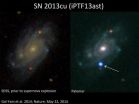(Press-News.org) A type of retina cell plays a more critical role in vision than previously known, a team led by Johns Hopkins University researchers has discovered.
Working with mice, the scientists found that the ipRGCs – an atypical type of photoreceptor in the retina – help detect contrast between light and dark, a crucial element in the formation of visual images. The key to the discovery is the fact that the cells express melanopsin, a type of photopigment that undergoes a chemical change when it absorbs light.
"We are quite excited that melanopsin signaling contributes to vision even in the presence of functional rods and cones," postdoctoral fellow Tiffany M. Schmidt said.
Schmidt is lead author of a recently published study in the journal Neuron. The senior author is Samer Hattar, associate professor of biology in the university's Krieger School of Arts and Sciences. Their findings have implications for future studies of blindness or impaired vision.
Rods and cones are the most well-known photoreceptors in the retina, activating in different light environments. Rods, of which there are about 120 million in the human eye, are highly sensitive to light and turn on in dim or low-light environments. Meanwhile the 6 million to 7 million cones in the eye are less sensitive to light; they drive vision in brighter light conditions and are essential for color detection.
Rods and cones were thought to be the only light-sensing photoreceptors in the retina until about a decade ago when scientists discovered a third type of retinal photoreceptor – the ipRGC, or intrinsically photosensitive retinal ganglion cell – that contains melanopsin. Those cells were thought to be needed exclusively for detecting light for non-image-dependent functions, for example, to control synchronization of our internal biological clocks to daytime and the constriction of our pupils in response to light.
"Rods and cones were thought to mediate vision and ipRGCs were thought to mediate these simple light-detecting functions that happen outside of conscious perception," Schmidt said. "But our experiments revealed that ipRGCs influence a greater diversity of behaviors than was previously known and actually contribute to an important aspect of image-forming vision, namely contrast detection."
The Johns Hopkins team along with other scientists conducted several experiments with mice and found that when melanopin was present in the retinal ganglion cells, the mice were better able to see contrast in a Y-shaped maze, known as the visual water task test. In the test, mice are trained to associate a pattern with a hidden platform that allows them to escape the water. Mice that had the melanopsin gene intact had higher contrast sensitivity than mice that lack the gene.
"Melanopsin signaling is essential for full contrast sensitivity in mouse visual functions," said Hattar. "The ipRGCs and melanopsin determine the threshold for detecting edges in the visual scene, which means that visual functions that were thought to be solely mediated by rods and cones are now influenced by this system. The next step is to determine if melanopsin plays a similar role in the human retina for image-forming visual functions."
INFORMATION:
Other co-authors on the Neuron paper are Nazia M. Alam and Glen T. Prusky from Burke Medical Research Institute, Shan Chen and Wei Li from the National Eye Institute at the National Institutes of Health and Paulo Kofuji from the University of Minnesota.
This research was funded by the National Institutes of Health grants GM076430 and EY022543, the NIH Intramural Research Program and the Burke Foundation.
JHU biologists identify new neural pathway in eyes that aids in vision
2014-05-21
ELSE PRESS RELEASES FROM THIS DATE:
Blowing in the (stellar) wind
2014-05-21
When a supernova – the explosion of a distant star —was discovered last year, astrophysicists, with the help of telescopes around the globe, rushed to observe the fireworks. In its dramatic dying flares, this star – a rare type over 10 times the mass of our sun – can tell us something about the life of these fascinating cosmic bodies, as well as helping paint the picture of how all the heavier elements in the universe are formed.
To understand the star that produced the supernova, the researchers identified the mix of elements that was thrown off right before the explosion ...
Panel of 11 genes predicts alcoholism risk, gives new insights into biology of the disease
2014-05-21
INDIANAPOLIS -- A group of 11 genes can successfully predict whether an individual is at increased risk of alcoholism, a research team from the United States and Germany reported Tuesday.
"This powerful panel of just 11 genes successfully identified who has problems with alcohol abuse and who does not in tests in three patient populations on two continents, in two ethnicities and in both genders," said Alexander B. Niculescu III, M.D., Ph.D., principal investigators and associate professor of psychiatry and medical neuroscience at the Indiana University School of Medicine. ...
A new strategy for diabetes treatment
2014-05-21
With the discovery of a compound that can slow the degradation of insulin in animals, scientists at Harvard have opened the door to a potential new treatment for diabetes.
The new approach, described by Professor of Chemistry and Chemical Biology David Liu and Associate Professor of Chemistry and Chemical Biology Alan Saghatelian, uses a newly discovered compound to inhibit insulin degrading enzyme (IDE). Inhibiting IDE in mice, they show, elevates insulin levels and promotes insulin signaling in vivo. Eventually, the use of this compound in patients may help maintain ...
Confirmed: Stellar behemoth self-destructs in a Type IIb supernova
2014-05-21
Our Sun may seem pretty impressive: 330,000 times as massive as Earth, it accounts for 99.86 percent of the Solar System's total mass; it generates about 400 trillion trillion watts of power per second; and it has a surface temperature of about 10,000 degrees Celsius. Yet for a star, it's a lightweight.
The real cosmic behemoths are Wolf-Rayet stars, which are more than 20 times as massive as the Sun and at least five times as hot. Because these stars are relatively rare and often obscured, scientists don't know much about how they form, live and die. But this is changing, ...
Soil bacteria may provide clues to curbing antibiotic resistance
2014-05-21
Drug-resistant bacteria annually sicken 2 million Americans and kill at least 23,000. A driving force behind this growing public health threat is the ability of bacteria to share genes that provide antibiotic resistance.
Bacteria that naturally live in the soil have a vast collection of genes to fight off antibiotics, but they are much less likely to share these genes, a new study by researchers at Washington University School of Medicine in St. Louis has revealed. The findings suggest that most genes from soil bacteria are not poised to contribute to antibiotic resistance ...
New technique reveals supernova progenitor
2014-05-21
Washington, D.C.—Wolf-Rayet stars are very large and very hot. Astronomers have long wondered whether Wolf-Rayet stars are the progenitors of certain types of supernovae. New work from the Palomar Transient Factory team, including Carnegie's Mansi Kasliwal, is homing in on the answer. They have identified a Wolf-Rayet star as the likely progenitor of a recently exploded supernova. This work is published by Nature.
Wolf-Rayet stars are notable for having strong stellar winds and being deficient in hydrogen when compared with other stars. Taken together, these two factors ...
Study shows image fusion-guided biopsy improves accuracy of prostate cancer diagnosis
2014-05-21
NEW HYDE PARK, NY – A recent study by investigators from LIJ Medical Center demonstrated that using magnetic resonance imaging (MRI) in men with an elevated prostate specific antigen (PSA) resulted in a prostate cancer detection rate that was twice as high as data reported in the March 1999 Prostate journal that analyzed men undergoing the standard 12-core biopsy with an elevated PSA. Physicians in the recent trial used a targeted approach to evaluate prostate cancer that combines MR imaging and transrectal ultrasound fusion guided prostate biopsy.
Given the limitations ...
Too cute to resist: Do whimsical products make consumers overspend?
2014-05-21
Babies are cute. Kittens are cute. But for some people, products that emphasize baby features like chubby cheeks and large eyes cause them to be more careful and restrained. According to a new study in the Journal of Consumer Research, products that are cute in a playful and whimsical way can bring out more indulgent behavior.
"We were not convinced that all cute products would lead to the restrained behavior that stems from baby-cuteness. Our research examined whether there are indeed different types of cuteness, and if these differences could lead to more or less indulgent ...
Buying a BMW: How do social expectations influence your purchases?
2014-05-21
People who drive BMWs and wear expensive suits must surely occupy roles of power and authority. According to a new study in the Journal of Consumer Research, when we can separate societal expectations of power from how power makes us feel, we have better control over what it means to be powerful.
"When a person is placed into a powerless or powerful role, they sometimes conform to the expectations of that role. But when they are focused on the internal feeling of having or lacking power, we observed the opposite patterns of behavior," write authors Derek D. Rucker (Kellogg ...
What makes things cool? When breaking the rules can boost your cool factor
2014-05-21
Coolness helps sell everything from fashion and music to electronics and cigarettes. According to a new study in the Journal of Consumer Research, people and brands become cool by understanding what is considered normal, obeying the rules considered necessary, and then diverging from the rules considered expendable.
"Our research explores how brands and people become cool in the eyes of consumers. We reasoned that brands could become cool by breaking rules that seemed unnecessary or unfair, but not by breaking legitimate rules," write authors Caleb Warren (Texas A&M University) ...

